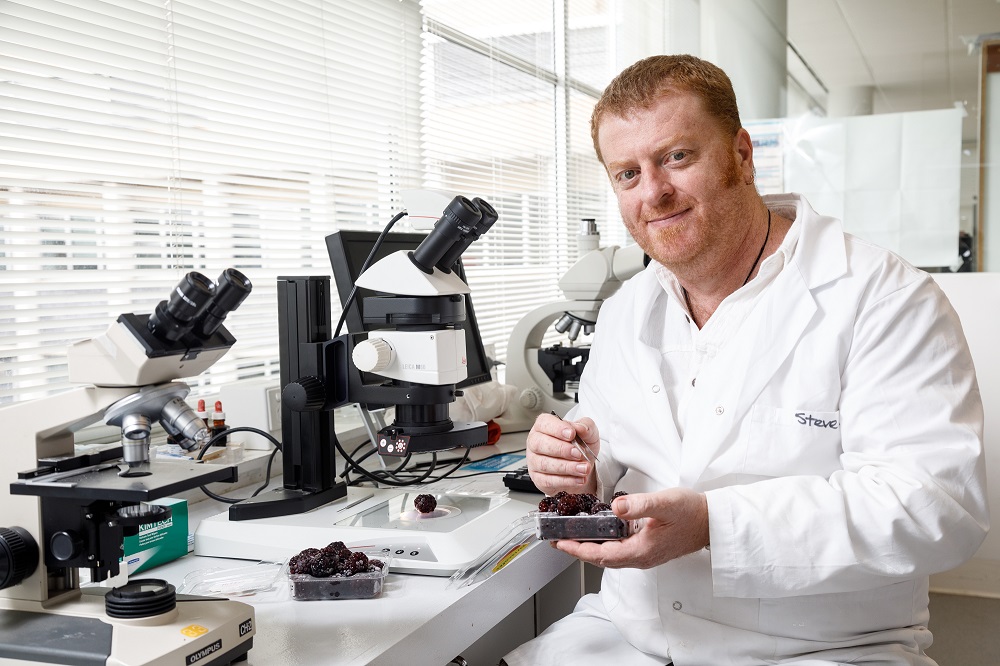Not all bugs are bad. In fact, some insects play an important role in combating pests in many crops and helping growers reduce their pesticide use.
A national research team led by Tasmanian Institute of Agriculture (TIA) Entomologist, Dr Stephen Quarrell, will survey rubus crops (raspberry and blackberry) in the key growing regions of Tasmania, New South Wales, and Victoria over the next year. The aim is to find out which pest and beneficial insect species are already present and identify possible new biological control options.
The survey results will inform a new five-year $2.4 million project that aims to help growers manage and prevent pest outbreaks by using integrated pest management (IPM) strategies. On-farm research and demonstration in the major production regions, including Tasmania, will give a practical focus to the project along with grower workshops for sharing and discussing project results and the practicalities of implementing new IPM strategies.
“We need to look at the bigger picture when it comes to pest management so we can achieve better outcomes for growers – including in protected cropping environments. Our goal is to help growers make informed decisions around what strategy is most appropriate at any given time and situation, with spraying as the absolute last resort,” Dr Quarrell said.
“Through our previous work on redberry mite management we observed a predatory mite species Typhlodromus dossei that is not currently commercially reared. We want to know more about this species and how it could be used as a future biocontrol agent to fill a gap in mite management in rubus crops. This is just one example of a new option to be explored through this project.
Increasing flowering plant diversity
The project will also explore the establishment of increasing flowering plant diversity in and around polytunnels to attract beneficial insects – and Dr Quarrell believes this research could be a world-first.
“Growers are introducing beneficial species onto their farms multiple times during the long rubus season to reduce pest numbers but this can be expensive. Protecting beneficial species and natural predators is a way of ensuring a better return on investment,” Dr Quarrell said.
“We want to establish flowering plants on farm to create protective areas and alternative food sources for beneficial insects including pollinators. These areas aren’t treated with insecticide so they become refuges that protect and encourage beneficial insect populations that can move back into the crop if a pesticide application is needed.
“We are also looking at increasing plant biodiversity on farm with the inclusion of flowering ground covers where grass would usually be, and structural plants along tree lines and shelter belts.”
Dr Quarrell said that finding the best way to establish flowering plant diversity in polytunnels without losing any of the cropping area would be a challenge.
“We think it could be possible to remove some guttering from between polytunnels and introducing plants in those areas and we are envisioning banks of flowering plants. Berry patches and polytunnels could look a lot different in the future – there will certainly be a lot more insects flying around,” Dr Quarrell said

Trap cropping
The other element of the project is trap cropping, which is the establishment of a sacrificial crop to attract pests away from the main berry crop.
“For example, we know that mirids are more attracted to lucerne than berries, so we could plant lucerne around crop like a ‘bug magnet’ and then spray the lucerne instead of the berry crop,” Dr Quarrell said.
It’s an important project for the rapidly expanding berry sector. The latest Tasmanian AgriFood Score Card reveals that berries have become Tasmania’s most valuable fruit industry with a farmgate value of $209 million in 2020-21, a 63 per cent increase from the previous year. Raspberries and blackberries are the industry’s most valuable categories accounting for almost 60 per cent of the berry industry’s value.
Dr Quarrell said IPM requires more hands-on work than conventional practices, but interest is building as growers become aware of the numerous financial and environmental benefits of IPM.
“It requires a shift in mindset to realise that a zero tolerance for pests is not necessary, and that the important thing is ensuring pest numbers don’t go above a threshold where they become a problem,” Dr Quarrell said.
“Growers will keep a close eye on their crops to look for pest outbreaks and then use targeted interventions rather than treating the whole crop. An intervention might be to do nothing and come back and look in a week to see what is going on before choosing a management option with spraying as a last resort.”
The project Integrated pest management approaches to address pest challenges in raspberry and blackberry has been funded by Hort Innovation using the raspberry and blackberry research and development levy and contributions from the Australian Government and co-investment from the University of Tasmania, Agriculture Victoria, and NSW Department of Primary Industries.
Sign-up to TIA's mailing list to receive the latest news and events straight to your inbox.
TIA is a joint venture between the University of Tasmania and the Tasmanian Government.
Banner image credit: Moon Cheese Studio


